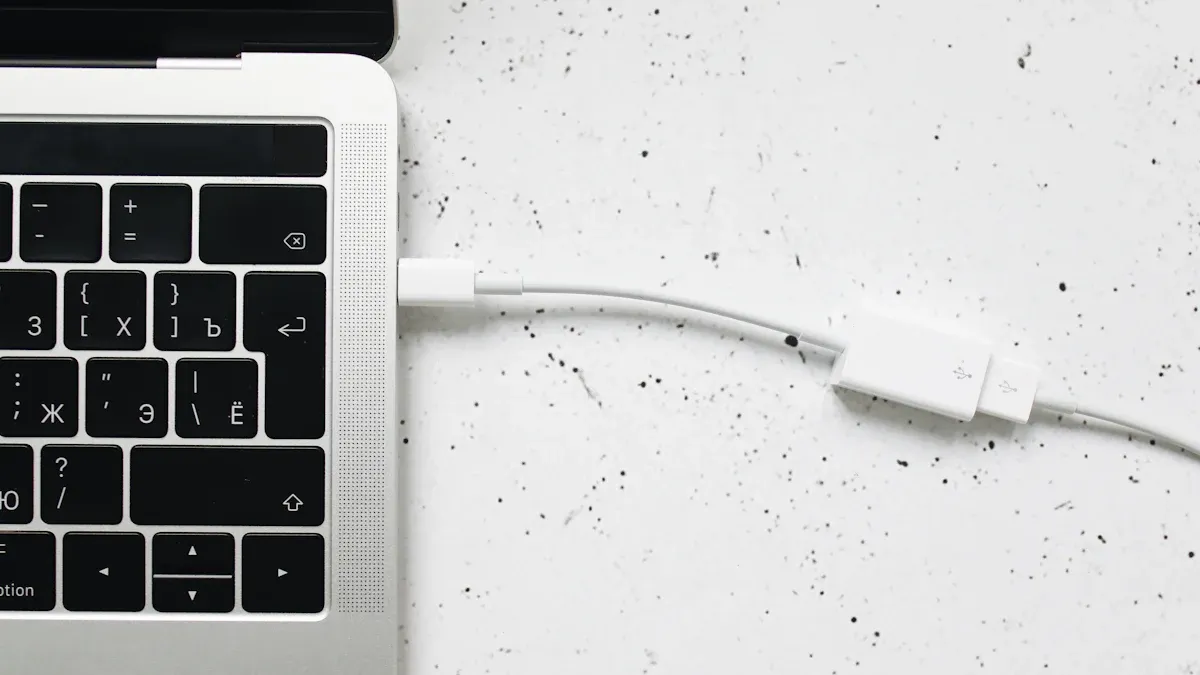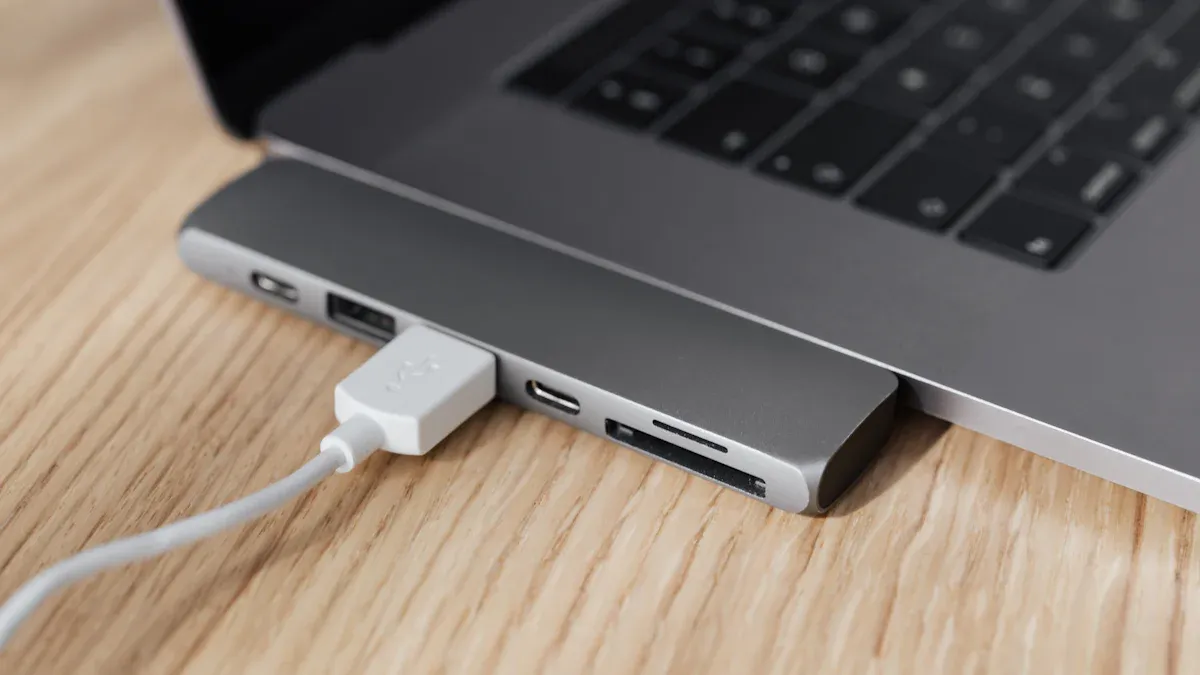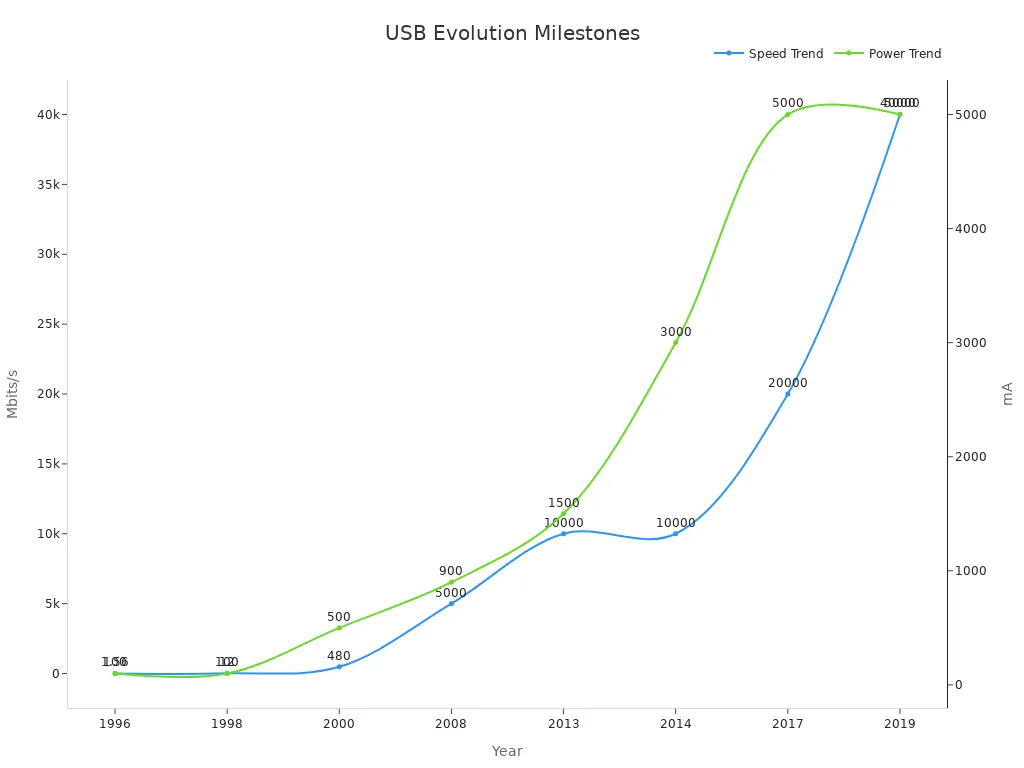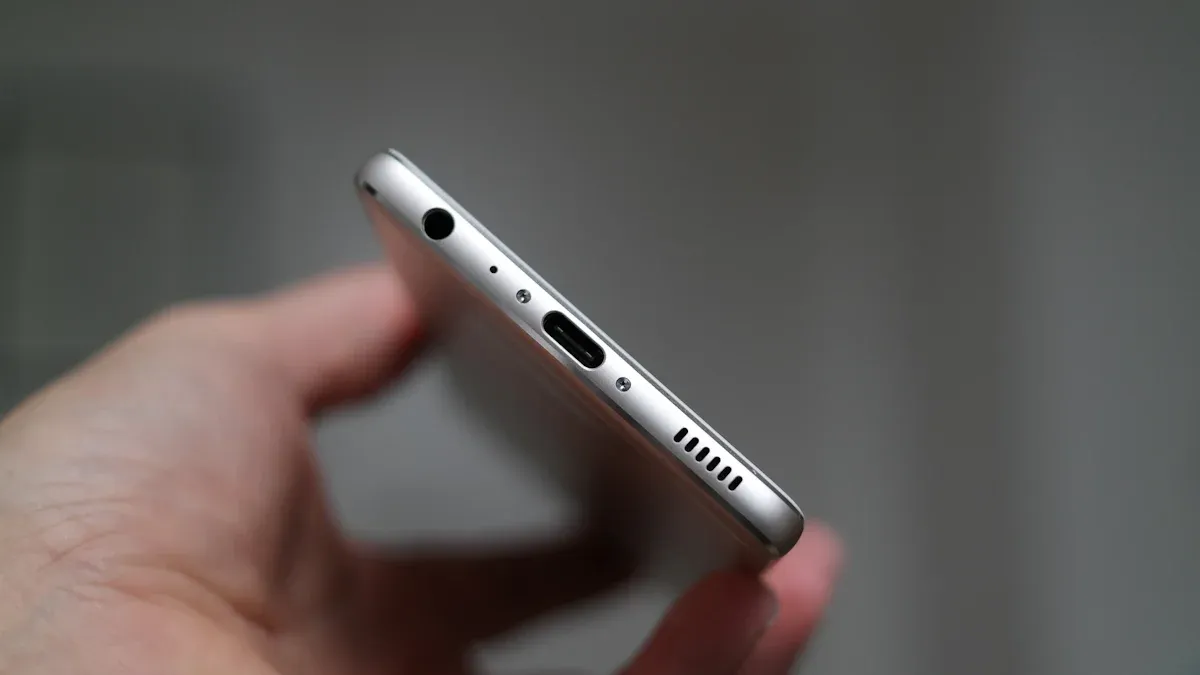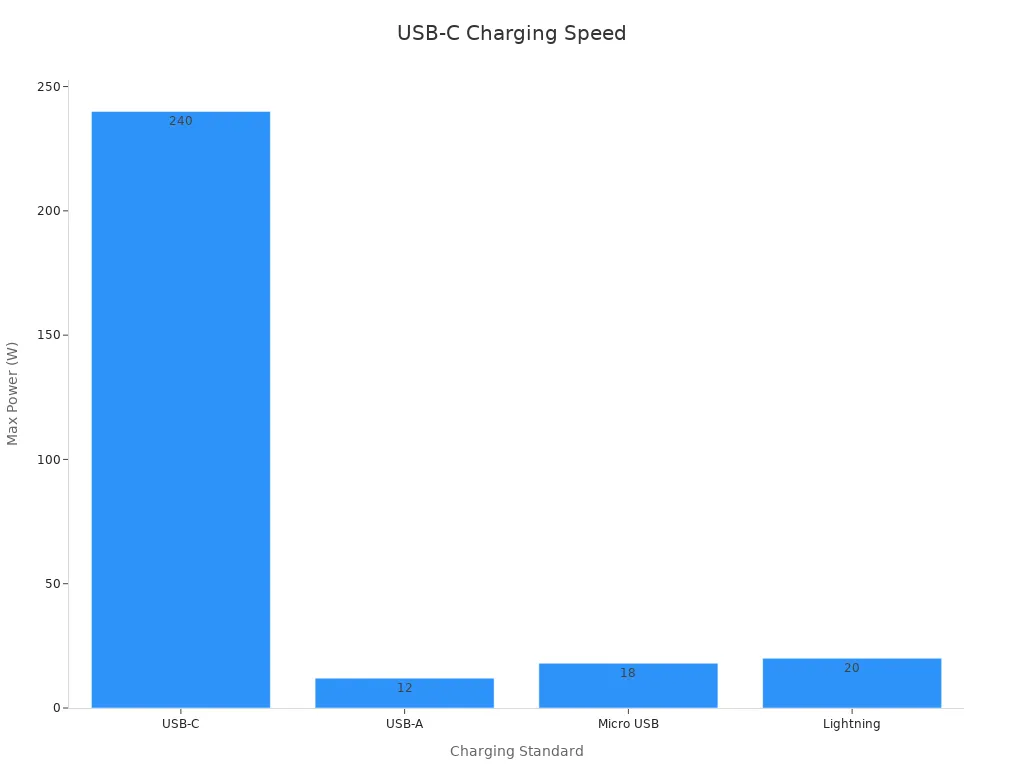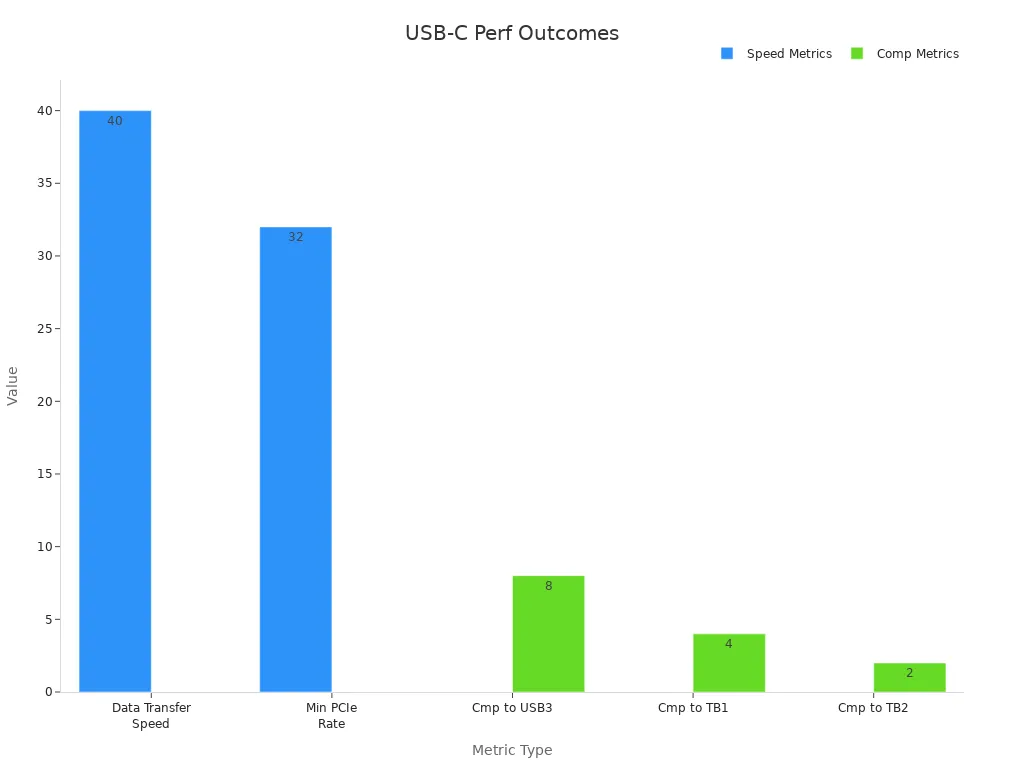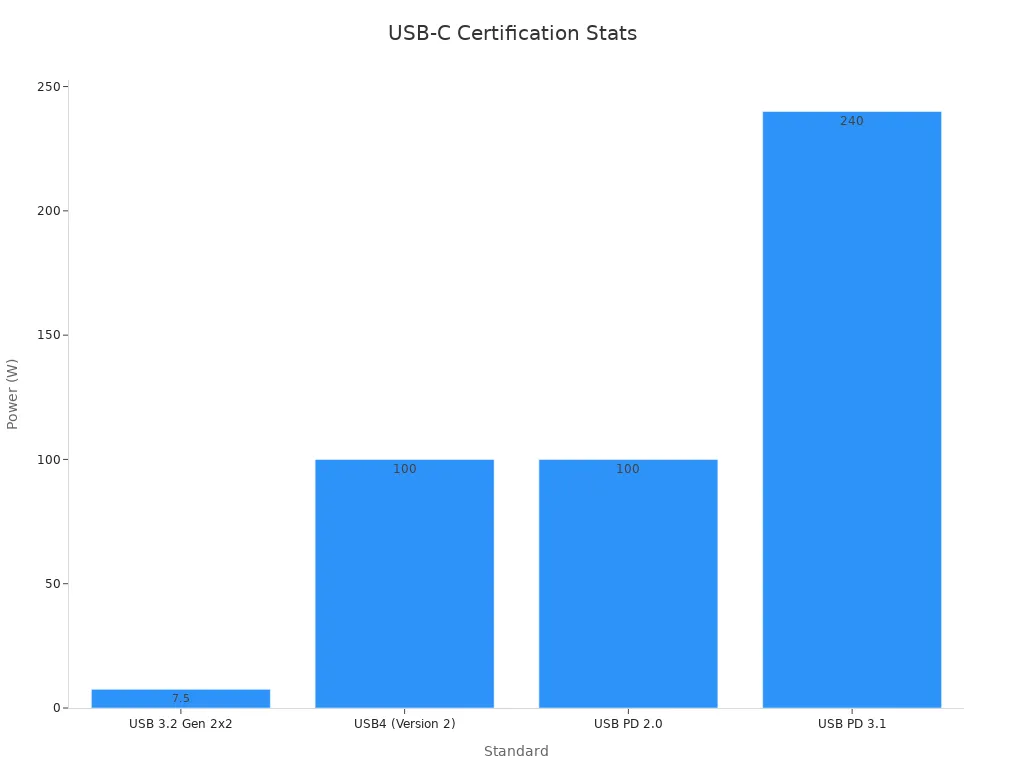The USB Type C charging port has become a game-changer in modern technology. Its compact and reversible design makes connecting your devices effortless. Unlike older USB ports, USB-C supports faster charging and high-speed data transfer, ensuring a seamless experience. Adoption rates are skyrocketing, driven by regulatory mandates like the European Union’s 2024 USB-C standard for mobile devices. The market for USB-C is projected to grow from $33.4 billion in 2025 to $139.6 billion by 2035, highlighting its importance in the tech landscape. With USB-C, you enjoy efficiency, compatibility, and innovation in one charging port.
Understanding the USB Type C Charging Port
Evolution of USB ports to USB-C
The journey of USB technology began in 1996 with USB 1.0, which offered a modest data transfer speed of 1.56 Mbits/s and minimal power delivery. Over the years, USB technology evolved significantly, with each version bringing faster speeds and higher power capabilities. For example, USB 3.0, introduced in 2008, delivered speeds up to 5 Gbps, while USB 3.2 in 2017 doubled that to 20 Gbps. The introduction of USB Type-C in 2014 marked a turning point. It combined a compact design with enhanced functionality, supporting up to 10 Gbps data transfer and 3A power delivery.
USB-C has since become the standard for modern devices, offering universal compatibility and improved performance. Its ability to support USB4 and Thunderbolt further cements its role as the future of connectivity.
Unique features of USB-C: Reversible design and compact size
One of the standout features of USB-C is its reversible design. Unlike older USB connectors, you no longer need to worry about the orientation when plugging in your cable. This symmetrical design simplifies your experience and reduces wear on the port. The rounded edges of the USB-C plug also make it self-aligning, ensuring a smooth connection every time.
The compact size of USB-C is another game-changer. It is significantly smaller than legacy connectors, allowing manufacturers to create thinner and lighter devices. This feature has contributed to the sleek designs of modern smartphones, laptops, and tablets. Additionally, USB-C reduces the need for multiple ports, streamlining device designs without compromising functionality.
How USB-C enhances versatility and user experience
USB-C offers unmatched versatility, making it a favorite among users and manufacturers alike. Its high-speed data transfer capabilities, reaching up to 10 Gbps, allow you to move large files quickly. With Thunderbolt compatibility, USB-C can achieve speeds of up to 40 Gbps and support video output for up to 8K resolution. This makes it ideal for professionals who need reliable performance for tasks like video editing or data analysis.
The USB-C charging port also supports Power Delivery, providing up to 100W of power. This means you can charge everything from smartphones to laptops with a single USB-C charger. Its universal compatibility ensures that you can use one cable across multiple devices, reducing clutter and enhancing convenience. These benefits make USB-C an essential feature in modern technology.
Benefits of USB-C Technology
Faster charging with USB-C
USB-C technology has revolutionized charging by offering faster charging times and higher power delivery. With USB Power Delivery (USB-PD), USB-C can deliver up to 240W of power, making it ideal for charging everything from smartphones to laptops. This is a significant improvement compared to older standards like USB-A, which maxes out at 12W. Faster charging means you spend less time waiting for your devices to power up and more time using them.
Here’s a comparison of charging standards to highlight USB-C’s efficiency:
| Charging Standard | Max Power Output | Fast Charging Support | Data Transfer Speed |
|---|---|---|---|
| USB-C | Up to 240W (48V/5A) | Yes, with USB Power Delivery (USB-PD) | Up to 40Gbps (with Thunderbolt 4) |
| USB-A | Up to 12W (5V/2.4A) | Limited | Up to 480Mbps (USB 2.0) |
| Micro USB | Up to 18W (with Qualcomm Quick Charge) | Limited | Up to 480Mbps (USB 2.0) |
| Lightning | Up to 20W | Limited | Up to 480Mbps (USB 2.0) |
This table and chart clearly show how USB-C outperforms older technologies in both power output and data transfer speeds. By using a USB-C charger, you can enjoy quick charging and improved efficiency.
Universal compatibility for devices and brands
One of the greatest benefits of USB-C is its universal compatibility. You no longer need to carry multiple chargers for different devices. USB-C works seamlessly across a wide range of electronics, including smartphones, laptops, tablets, and even gaming consoles. Major tech companies like Apple, Google, and Microsoft have adopted USB-C as their standard, ensuring that you can use one cable for all your devices.
The European Parliament has also mandated USB-C as the universal charging port for electronic devices. By December 28, 2024, all smartphones, tablets, cameras, and handheld consoles sold in the EU must include USB-C ports. Laptops will follow suit by April 2026. This regulatory push ensures that USB-C will remain the standard for years to come, making it easier for you to charge and connect your devices.
Here are some key points about USB-C’s compatibility:
- USB-C is supported by major brands like Apple, Google, and Microsoft.
- It works with a variety of devices, including laptops, smartphones, and gaming consoles.
- Audio accessories are increasingly designed to be USB-C compatible.
This universal compatibility reduces clutter and simplifies your life, allowing you to focus on what matters most.
High-speed data transfer and video output
USB-C doesn’t just excel at charging; it also offers faster data transfer and advanced video output capabilities. With data transfer speeds of up to 40 Gbps when paired with Thunderbolt 4, USB-C allows you to move large files in seconds. This is a massive leap compared to older standards like USB 2.0, which only supports speeds of up to 480 Mbps.
Here’s a breakdown of USB data transfer speeds over time:
- USB 2.0: Up to 480 Mbps
- USB 3.0: Up to 5 Gbps
- USB 3.1 and USB 3.2: Up to 10 Gbps and 20 Gbps, respectively
- Thunderbolt 4 (via USB-C): Up to 40 Gbps
USB-C also supports DisplayPort 2.0, enabling video output at 8K resolution with HDR10 color. This makes it perfect for professionals who need high-quality visuals for video editing or presentations. With bandwidth up to 80 Gbps, USB-C ensures smooth and reliable performance for even the most demanding tasks.
Tip: If you’re looking for a single solution for charging, data transfer, and video output, USB-C is the way to go. Its versatility and speed make it an essential feature for modern devices.
By choosing devices with a USB type-c charging port, you gain access to faster data transfer, high-resolution video output, and unmatched efficiency.
Why USB-C is the ideal usb c charger for modern devices
USB-C has become the go-to choice for modern devices, and for good reason. Its advanced features and universal compatibility make it the ideal usb c charger for your gadgets. Whether you’re charging a smartphone, laptop, or tablet, USB-C delivers unmatched performance and convenience.
Faster charging for all your devices
One of the biggest benefits of USB-C is its ability to provide faster charging. With USB Power Delivery (USB-PD), USB-C can deliver up to 240W of power. This means you can charge your devices in a fraction of the time it takes with older USB standards. For example, a USB-C charger can power up a smartphone to 50% in just 30 minutes. This efficiency saves you time and keeps your devices ready when you need them.
Tip: To get the most out of USB-C’s faster charging capabilities, use certified cables and chargers that support USB-PD.
Universal compatibility simplifies your life
USB-C works with a wide range of devices, making it incredibly versatile. You can use the same USB-C cable to charge your laptop, transfer data from your smartphone, and connect to an external monitor. This eliminates the need for multiple chargers and cables, reducing clutter and making your life easier. Major brands like Apple, Samsung, and Dell have adopted USB-C, ensuring that it works seamlessly across different devices.
Compact design for modern gadgets
The compact size of USB-C is another reason why it’s the ideal choice for today’s devices. Its small, reversible connector fits easily into slim laptops, tablets, and smartphones. This design not only saves space but also makes it easier to plug in your cable without worrying about the orientation. The USB type c charging port has become a standard feature in modern gadgets, thanks to its sleek and efficient design.
High-speed data transfer and video output
USB-C isn’t just about charging. It also supports high-speed data transfer and video output, making it a multifunctional solution. With data transfer speeds of up to 40 Gbps when paired with Thunderbolt, USB-C allows you to move large files quickly. It also supports 8K video output, making it perfect for professionals who need high-quality visuals. This versatility makes USB-C an essential feature for both work and entertainment.
Future-proof technology
As technology evolves, USB-C continues to adapt and improve. Its ability to support USB4 and Thunderbolt ensures that it will remain relevant for years to come. By choosing devices with a USB type-c charging port, you’re investing in a future-proof solution that will keep up with your needs.
Technical Aspects of USB-C
Power delivery and fast charging protocols
USB-C technology has redefined how you charge your devices by introducing enhanced power delivery and fast charging protocols. The USB-C standard supports USB Power Delivery (USB-PD), which allows for dynamic power adjustments based on the needs of your device. This ensures reliable and efficient charging while protecting your gadgets from overcharging or overheating.
Here’s a breakdown of USB-C’s power delivery capabilities:
| Feature | Description |
|---|---|
| Maximum Power Delivery | Up to 100 watts, sufficient for charging laptops and high-power devices. |
| Voltage Levels | Supports multiple voltage levels: 5V, 9V, 15V, and 20V. |
| Current Capacity | Can deliver up to 5A current, allowing for faster charging. |
| Compatibility | Works with USB 3.1 and USB Power Delivery 2.0 specifications. |
| Two-way Charging | Allows devices to charge each other, enhancing versatility. |
| Compliance Testing | USB-IF compliance ensures that cables meet power and data transfer standards. |
| Environmental Benefits | Reduces electronic waste by standardizing charging solutions across devices. |
USB-C PD can charge devices up to 70% faster than standard USB chargers. For example, a USB-C charger can power up a smartphone to 50% in just 30 minutes. This faster charging time saves you valuable time and ensures your devices are always ready to use. Additionally, the two-way charging capability allows you to charge one device using another, adding to the convenience and efficiency of USB-C technology.
Tip: Always use certified USB-C cables and chargers to maximize charging speed and ensure device safety.
Data transfer speeds and Thunderbolt integration
USB-C doesn’t just excel at charging; it also delivers high-speed data transfer capabilities. When paired with Thunderbolt integration, USB-C achieves remarkable performance, making it a cutting-edge solution for modern devices. Thunderbolt 4, which uses the USB-C connector, offers data transfer speeds of up to 40 Gbps. This is eight times faster than USB 3.0 and twice as fast as Thunderbolt 2.
Here’s a comparison of USB-C’s data transfer speeds:
| Feature | Specification |
|---|---|
| Data Transfer Speed | Up to 40 Gbps (bidirectional) |
| Comparison to USB 3.0 | 8 times faster |
| Comparison to Thunderbolt 1 | 4 times faster |
| Comparison to Thunderbolt 2 | 2 times faster |
| Minimum PCIe Data Rate | 32 Gbps (twice that of Thunderbolt 3) |
| Video Support | One 8K monitor (30 Hz) or two 4K monitors (60 Hz) |
Thunderbolt integration also enhances USB-C’s video output capabilities. You can connect to an 8K monitor or two 4K monitors simultaneously, making it ideal for professionals who require high-resolution displays. Whether you’re transferring large files or streaming ultra-high-definition video, USB-C ensures unmatched performance.
USB-C’s role in supporting advanced connectivity
USB-C plays a pivotal role in modern device integration by supporting advanced connectivity features. Its versatility allows you to connect multiple devices, transfer data at high speeds, and power your gadgets—all through a single port. USB-C 3.2 Gen 2×2 supports speeds up to 20 Gbps, while Thunderbolt and USB4 compatibility push this limit to 40 Gbps.
Here are some key metrics that highlight USB-C’s advanced connectivity:
| Metric | Description |
|---|---|
| Peak Data Transfer Speeds | High-speed USB C cables can achieve up to 20Gbps for USB4, significantly improving data transfer rates. |
| Thunderbolt and USB4 Support | Supports data transfer speeds of up to 40Gbps for Thunderbolt and 10Gbps or 20Gbps for USB4, enhancing connectivity. |
| Video Output Capabilities | Can drive 8K displays or multiple 4K displays, catering to high-resolution display needs. |
USB-C also supports multiple display configurations, including dual 4K monitors at 60 Hz. This makes it an excellent choice for multitasking, gaming, or professional work. Additionally, its enhanced power delivery capabilities of up to 100W ensure that you can charge and power multiple devices simultaneously.
Note: USB-C’s universal compatibility with USB4 and Thunderbolt™ 4 ensures that it remains a future-proof solution for your connectivity needs.
By choosing devices with a USB type-c charging port, you gain access to cutting-edge USB-C chargers, faster charging times, high-speed data transfer, and advanced connectivity options. This makes USB-C an indispensable feature in today’s technology landscape.
Safety and Reliability of USB-C
Overcharge protection and heat management
USB-C technology prioritizes your device’s safety by incorporating advanced overcharge protection and heat management systems. These features ensure that your devices remain secure during charging. USB-C chargers monitor the charging process and adjust power output to prevent overcharging, which can damage battery cells. They also dissipate heat effectively to avoid overheating, even during fast charging sessions.
Here’s how USB-C safeguards your devices:
1. Overcharge Protection: USB-C chargers include cutoff mechanisms that stop charging once the battery reaches its maximum capacity. This prevents long-term damage to the battery.
2. Temperature Monitoring: USB-C chargers regulate battery temperature, especially under high-power conditions, to prevent swelling or overheating.
These features not only enhance safety but also improve the overall efficiency of the charging process, ensuring your devices last longer.
Certified cables and chargers for safe charging
Using certified USB-C cables and chargers is essential for safe and reliable charging. Certified products meet strict standards for power delivery and data transfer, ensuring they work seamlessly with your devices. For example, USB-C cables certified under USB Power Delivery (USB-PD) can handle up to 240W of power, making them suitable for high-power devices like laptops.
Here’s a quick comparison of USB-C certification standards:
| Standard | Power (Max) | Voltage | Current | Max Cable Length (Passive) |
|---|---|---|---|---|
| USB 3.2 Gen 2×2 | 7.5W | 5V | 1.5A | 1m |
| USB4 (Version 2) | 100W | 20V | 5A | 0.8m |
| USB PD 2.0 | 100W | 20V | 5A | 2m |
| USB PD 3.1 | 240W | 50V | 5A | 2m |
Certified USB-C products not only ensure safe charging but also deliver consistent performance, making them a reliable choice for your devices.
Ensuring device safety with USB-C technology
USB-C technology goes beyond just charging your devices. It ensures their safety through features like power delivery compliance and universal compatibility. USB-C chargers dynamically adjust voltage and current levels based on your device’s requirements, preventing electrical surges. Additionally, USB-C cables undergo rigorous compliance testing to meet USB-IF standards, ensuring they deliver both power and data safely.
By using USB-C, you can trust that your devices are protected from common risks like overheating, overcharging, and power surges. This makes USB-C not only a convenient option but also a reliable one for modern gadgets.
Future Trends in USB-C Technology
Advancements in charging speed and power delivery
USB-C technology is evolving rapidly, especially in charging speed and power delivery. The introduction of Extended Power Range (EPR) has pushed USB-C’s power capabilities to an impressive 240W. This advancement allows you to charge high-power devices like the 2023 Apple 16-inch MacBook Pro with ease. You no longer need bulky adapters for powerful gadgets. Additionally, Gallium Nitride (GaN) chargers are becoming more common. These chargers are smaller, more efficient, and generate less heat than traditional silicon-based chargers. With GaN technology, you can enjoy faster charging without worrying about overheating or bulky designs. These innovations make USB-C a leader in modern charging solutions.
Integration with USB4 and Thunderbolt 4
USB4 and Thunderbolt 4 have taken USB-C to the next level by enhancing speed, compatibility, and performance. Both technologies offer data transfer speeds of up to 40Gbps, ensuring you can move large files in seconds. They also support high-resolution displays, making them ideal for professionals and gamers. Here’s a comparison of their features:
| Feature | USB4 | Thunderbolt™ 4 |
|---|---|---|
| Speed | Up to 40Gbps | Up to 40Gbps |
| Compatibility | Backward compatible with USB-C 3.2 and Thunderbolt™ 3 | Supports USB4, PCIe, and Ethernet protocols |
| Power Delivery | Up to 100W | Up to 96W |
| Display Support | Single 8K/60Hz or Dual 4K/120Hz | Single 8K/60Hz with DSC or Dual 4K/60Hz |
These features ensure that USB-C remains a future-proof solution for your devices. Whether you’re transferring data, powering your laptop, or connecting to an 8K monitor, USB-C with USB4 or Thunderbolt 4 delivers unmatched performance.
USB-C’s role in sustainable and wireless technology
USB-C is also paving the way for a more sustainable and wireless future. Its universal compatibility reduces electronic waste by eliminating the need for multiple chargers and cables. You can use one USB-C charger for all your devices, simplifying your life and helping the environment. Additionally, USB-C supports wireless charging innovations. As wireless technology advances, USB-C will likely play a key role in enabling faster and more efficient wireless charging solutions. By adopting USB-C, you contribute to a greener and more connected world.
Tip: Look for USB-C devices with USB4 or Thunderbolt 4 compatibility to future-proof your tech setup and enjoy the latest advancements.
The usb type c charging port has transformed how you connect and power your devices. Its reversible design eliminates frustration, while fast data transfer speeds of up to 40Gbps save you time. With the ability to deliver up to 100 watts of power, USB-C ensures faster charging for laptops, smartphones, and more. Its universal compatibility simplifies your life by reducing the need for multiple cables. As a future-proof technology, USB-C supports the latest standards, making it an essential feature for modern devices. By adopting USB-C, you embrace efficiency, convenience, and sustainability in one compact solution.
FAQ
What devices are compatible with USB Type-C?
Most modern devices, including smartphones, laptops, tablets, and gaming consoles, support USB Type-C. Major brands like Apple, Samsung, and Dell use USB-C ports. You can check your device’s specifications to confirm compatibility.
Can USB-C cables charge all devices?
USB-C cables can charge most devices, but not all cables support high-power delivery or fast charging. Use certified USB-C cables with USB Power Delivery (USB-PD) for optimal performance and safety.
How do I know if my USB-C cable supports fast charging?
Look for USB-PD certification or check the cable’s specifications. Fast charging cables usually support higher wattage, such as 100W or 240W. Avoid generic cables without clear labeling.
Is USB-C better than older USB standards?
Yes, USB-C offers faster charging, higher data transfer speeds, and universal compatibility. Its reversible design and compact size make it more user-friendly than USB-A or Micro USB.
Can USB-C replace HDMI for video output?
USB-C supports video output through DisplayPort or Thunderbolt protocols. You can connect USB-C to HDMI adapters for high-resolution displays, including 4K and 8K monitors. Check your device’s specifications for compatibility.

